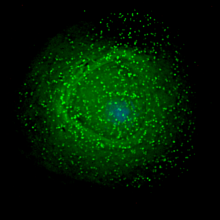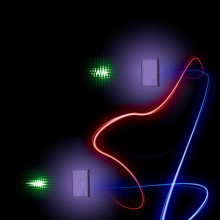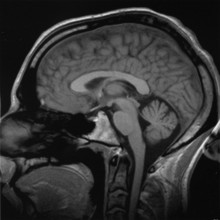In this Naked Scientists NewsFlash, we hear how the Voyager missions can now detect radiation given out by the birth of stars, discover a new vaccine for HIV that can completely block infection in experimental animals, and explore the computer programme that can spot when a photo's been "photoshopped". Plus, we meet some clever birds and ask if heading a football can cause brain damage.
In this episode

00:25 - Voyager Casts off the Hydrogen-Tinted Spectacles
Voyager Casts off the Hydrogen-Tinted Spectacles
This week a team of researchers in France, Russia and the USA have reported that Voyager Spacecrafts 1 & 2 - launched 34 years ago - have made it far enough out of the solar system to detect Lyman-alpha emission...
Lyman-alpha emission is an ultraviolet radiation generated when an electron moves between the first and second energy levels of hydrogen, and it is thought to be an indicator of regions where star formation has occurred. But in order to look at Lyman-alpha radiation you have to move far away from the clouds of hydrogen gas that are present in our solar system.
It is these hydrogen particles (called a heliospheric hydrogen glow) which can also scatter and disrupt Lyman-alpha radiation just as city lights can interfere with your view of the stars.
Both Voyagers have now travelled far enough away from the sun to look back and see through this hydrogen glow.
Previously Lyman-alpha emission has only been predicted with equations but, writing in the journal Science, Rosine Lallement and colleagues from The University of Paris Diderot can confirm that this emission has been detected and that it does have its origin in the regions surrounding newborn stars.
We can therefore use this information and look at other galaxies, as well as the Milky Way, in order to understand where a star formed. Sadly, Voyager 2's spectrometer has had to be switched off to conserve power, and the spectrometer on Voyager 1 will probably be turned off soon, too.
This means that those spacecraft will not be able to collect much more data on Lyman-alpha sources. It may be that the New Horizons Spacecraft (due to arrive at Pluto in 2015) can complete the data collection and look at the emission from other galaxies.

03:13 - Antibody-based vaccine for HIV
Antibody-based vaccine for HIV
A modified virus encoding an anti-AIDS antibody can protect animals from HIV infection...
An estimated 7000 new cases of HIV occur each day, the majority of them in developing countries where access to heathcare and antiretroviral drugs is limited. For this reason, a vaccine is urgently needed to control the spread of the infection.
Previous vaccine strategies have performed poorly, barely making a dent in infection rates, and so far the only intervention with proven longterm efficacy has been circumcision, which reduces a man's risk of acquiring the disease by 60-80%.
But a paper published this week in Nature by Caltech scientist David Baltimore and his colleagues might hint at a new way to combat the problem. They've used a self-complementary adeno-associated virus 8 (scAAV-8) as a vector, to ferry into experimental animals the DNA code for an antibody called b-12, which has HIV-neutralising properties.
This antibody, discovered some years ago, is special because it has the capacity to disable many different strains of HIV and can prevent infection becoming established in the first place.
The Caltech team injected 100 billion particles of the scAAV-8 vector into the leg muscles of experimental mice. These animals had also been modified to carry in their bloodstreams the human CD4 white cells targeted by HIV.
Within a week, high levels of the human b-12 antibody were detectable in the blood of the mice and expression was sustained for at least one year, which was the duration of the experiment.
The researchers then challenged the animals with an injection of HIV sufficiently large to infect the vast majority of unvaccinated mice and tracked the numbers of CD4 cells circulating in the bloodstream.
Compared with control mice, in which the CD4 count dropped nearly to zero, the b-12 antibody-producing animals showed complete protection against the infection.
The result is stunning, but not without a few residual wrinkles that need ironing out. This is a study in mice and so the concept would need to be proven in humans. Also, the long-term tolerability and safety of sc-AAV vectors and the effect of sustained high-level expression of the b-12 antibody are unknown, and it's unclear how much of the viral vector would be required to protect larger species including humans.
However, according to the team, who dub their technique "VIP" - vectored immunoprophylaxis - "given the level of protection that VIP has demonstrated in vivo, we believe that highly effective prophylaxis through expression of existing monoclonal antibodies against HIV in humans is achievable."

06:52 - Spooky Diamonds a Step Towards Quantum Computing
Spooky Diamonds a Step Towards Quantum Computing
This week, researchers from the UK, Canada and Singapore have accomplished quantum entanglement on the macro scale, entangling two millimetre-sized diamonds...
Typically we think of objects moving and interacting according to classical mechanics - i.e. Newton's Second Law - you apply a force to one object and it will cause it to accelerate in a particular direction. But in quantum mechanics there are extra complications, such as entanglement, where an action performed on one object will affect another - even if they are at a distance: something described by Einstein as 'spooky'.
Studying these quantum effects on objects any larger than an atomic particle is tough because there is so much environmental noise. Once in the 'macroscopic' scale, there are too many extra factors which are difficult to eliminate. The usual approach is to lower the temperature and so reduce thermal noise. Publishing in the journal Science, a team led by Ian Walmsley of Oxford University, took millimetre-wide pieces of diamond and tried to look at them in a more typical environment with an ambient temperature. To get around the problem of other noisy interactions that could interfere with results, they shortened the experiment to a matter of femtoseconds, and they did this using laser pulses.
Next came the entanglement, which they achieved by setting up a beam-splitter and detectors. They fired two laser pulses at each diamond, 350 femtoseconds apart. The second pulse picked up the energy the first pulse left behind before reaching the detector as an especially-energetic photon. If the system were classical, the second photon should pick up extra energy only half the time - only if it happened to hit the diamond where the energy was deposited in the first place.
But in 200 trillion trials, the team found that the second photon picked up extra energy every time. That means the energy was not contained within each diamond, but that they shared the same state as if they were one system. It had already been predicted that this could be done with larger objects at ambient temperature, but actually doing it is something else altogether so - although brief - this may be a step towards some real-world quantum computing, where entanglement allows you to store far more complex information than binary digits.

09:46 - Key to the Blood Brain Barrier
Key to the Blood Brain Barrier
A signal that controls the integrity of the blood brain barrier - the system that protects and chemically cocoons the brain from the rest of the body - has been discovered...
Early during embryonic development, the cells that line the blood vessels supplying the brain and spinal cord become tightly linked together, establishing a barrier that encloses the central nervous system and permits only certain things to pass through. Others, including immune cells, antibodies, chemicals and many pathogens are screened out.
But what controls the formation and operation of the blood brain barrier wasn't known. Now a team of scientists from Canada have cracked the problem and discovered the molecular key that locks and unlocks the barrier.
It all hinges, Alexandre Prat and his colleagues have shown, on a signal called sonic hedgehog. This is produced by brain cells called astrocytes, which are in contact with the endothelial cells in the blood vessels.
Writing in Science, the team show that, in the presence of sonic hedgehog, endothelial cells bind tightly together, immune cells and proteins are unable to escape from the cerebral circulation and the linings of the blood vessels express fewer cell adhesion molecules making it harder for inflammatory cells to cling on.
Applying a drug called cyclopamine, however, which blocks the action of sonic hedgehog, reversed all these effects. The drug also drammatically worsened the conditions of experimental animals with a multiple sclerosis (MS)-like disease caused by entry into the nervous system of white blood cells that attack the myelin sheath that surrounds nerve fibres. Reducing the integrity of the blood brain barrier appeared to enable more inflammatory cells to flock into the nervous system, amplifying the damage.
In line with this observation, brain samples tested from humans cases of MS show increased levels of sonic hedgehog production in areas where the disease was most active, suggesting that the brain upregulates the signal in an attempt to dampen inflammation.
Together, say the researchers, these data "provide compelling evidence suggesting a dual protective role for the hedgehog pathway at the level of the blood brain barrier and by acting as an endogenous anti-inflammatory system."
Moreover, these findings open up new therapeutic avenues that could be exploited to control entry of immune cells into the central nervous system and therefore reduce the rates of recurrence of MS attacks.

18:58 - Heading footballs and Gesturing Ravens
Heading footballs and Gesturing Ravens
Andrew Tobin, University of Leicester; Michael Lipton, Einstein school of Medicine; Thomas Bugnyar, Max Planck School of Ornithology.
New Malaria Drug Target
A new drug target to fight Malaria has been identified by scientists at the University of Leicester.The disease results in nearly 800,000 deaths globally each year and is caused by invasion of the parasite plasmodium falciparum in red blood cells . Current drugs on the market have started to see resistance develop against them causing scientists to be on the lookout for new ways to kill the parasite.
Now Andrew Tobin's team have identified a crucial group of proteins known as kinases needed by the parasite to survive in the bloodstream, making them a prime target to stop invasion.
'Headers' could cause brain injury
Too many headers when playing football could lead to serious brain injuries according to work presented at the annual meeting of the Radiological society of North America this week.
By scanning the brains of 32 amateur football players in the US, Michael Lipton from the Albert Einstein college of Medicine found that players who frequently header the ball during games had brain abnormalities in regions such as those responsible for memory and attention, causing changes similar to those in patients with traumatic brain injury or concussion.
Lipton identified a threshold level of 1000 to 1500 headers per year before significant damage is caused.
Gesturing Ravens
Ravens have been found to point and gesture at objects to attract each others attention, in a similar way to humans.
Previously, the only animal group thought to use gestures such as pointing to draw attention to something and holding an object for another to take, were the great apes. But now, after two years monitoring ravens in the wild, Thomas Bugnyar and colleagues from the Max Planck institute of Ornithology found the birds using their beaks to show or offer objects such as twigs and stones either to interest the opposite sex or strengthen social bonds.
The work adds further evidence to theories of a convergent evolution of the corvid bird family, which includes ravens, in parallel to the evolution of humans.










Comments
Add a comment